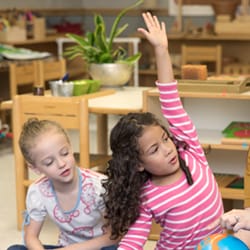The benefits of a Montessori education.
A Unique Approach to Education
The authentic Montessori Method for early childhood education is like no other approach out there. Those familiar with conventional teaching methods and school environments will discover a truly unique and different experience in a Montessori classroom.
The Montessori Difference
What makes the Montessori Method so unique? When you enter the calm, peaceful environment of a Montessori classroom, it may seem quite different from what you've come to expect from traditional educational environments. Here are a few differences you may notice.
Discover Your Child's True Potential
Throughout history, Montessori students have been empowered to realize their full potential and have gone on to change the world forever, for every one of us—and for the better. This transformative experience leads children to true self-discovery about themselves—and their future.
Montessori Research and Resources
There are a number of Montessori organizations with extensive knowledge and understanding of the authentic Montessori Method. These online resources offer insights and education into true Montessori experiences for curious families.
AMI/USA is the U.S. branch of the Association Montessori Internationale (AMI), the oldest, worldwide organization to champion the Montessori method, recognized as the leading authority on Montessori education.
The Montessori Foundation is an independent source of assistance, encouragement, and support to the international Montessori community. The Foundation also publishes the Montessori-themed magazine, Tomorrow's Child.
The Center supports a robust network of practitioners, researchers, parents, and leaders committed to Maria Montessori’s vision of education and development of the child’s potential.
The AMS Research Library offers Montessori-related resources and high-quality research to educators and researchers. Their hope is to encourage new research to strengthen existing knowledge of Montessori.
Experience Montessori for Yourself
Explore all the details you need to know about admissions, tuition, and more. Plus, find your neighborhood Montessori school and schedule a tour today.
Discover Our SchoolsInside the Montessori Classroom
Explore the Prepared Environment of a Montessori classroom and get a sense of the world of opportunities available to your child through this unique way to learn.
Explore the Classroom
